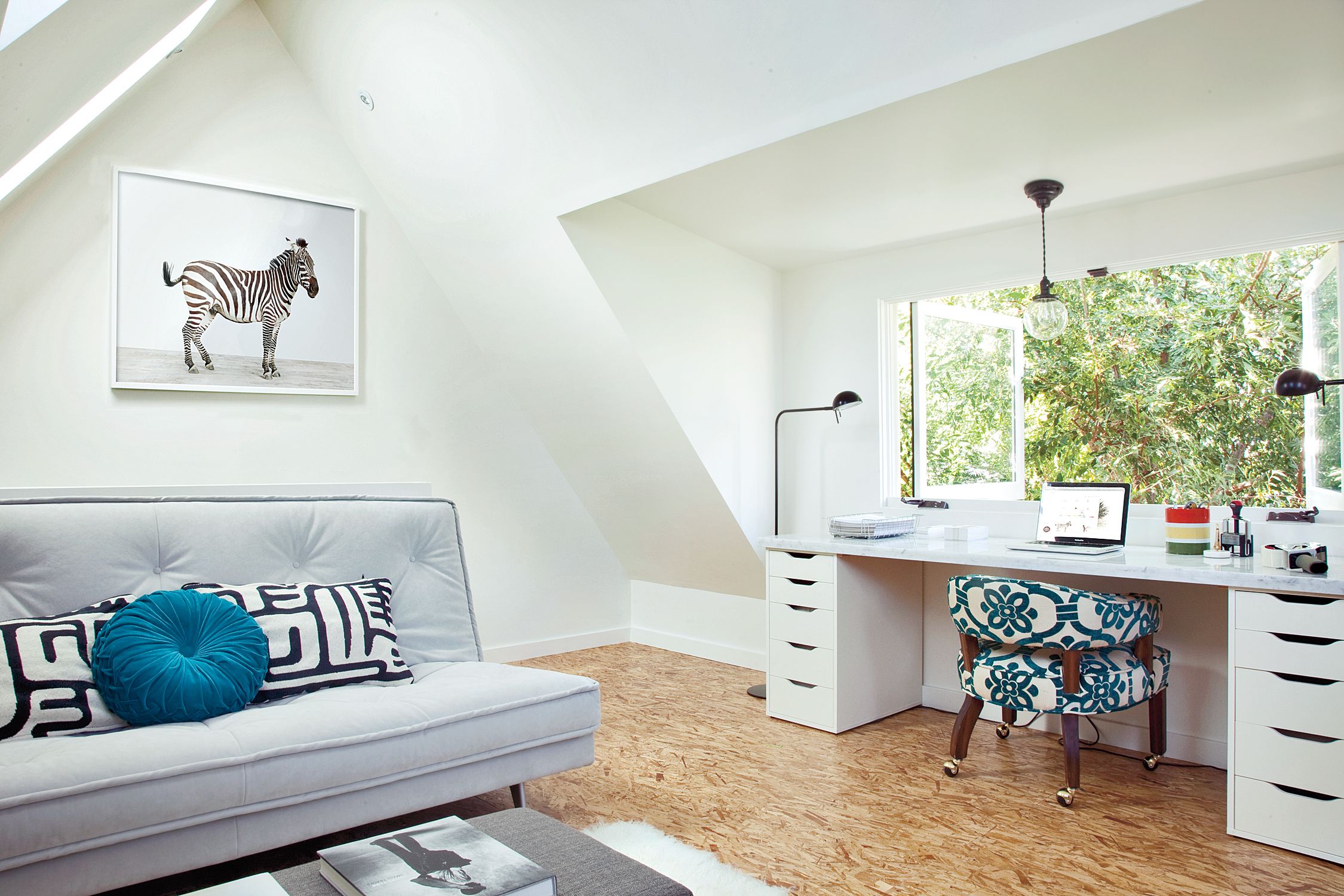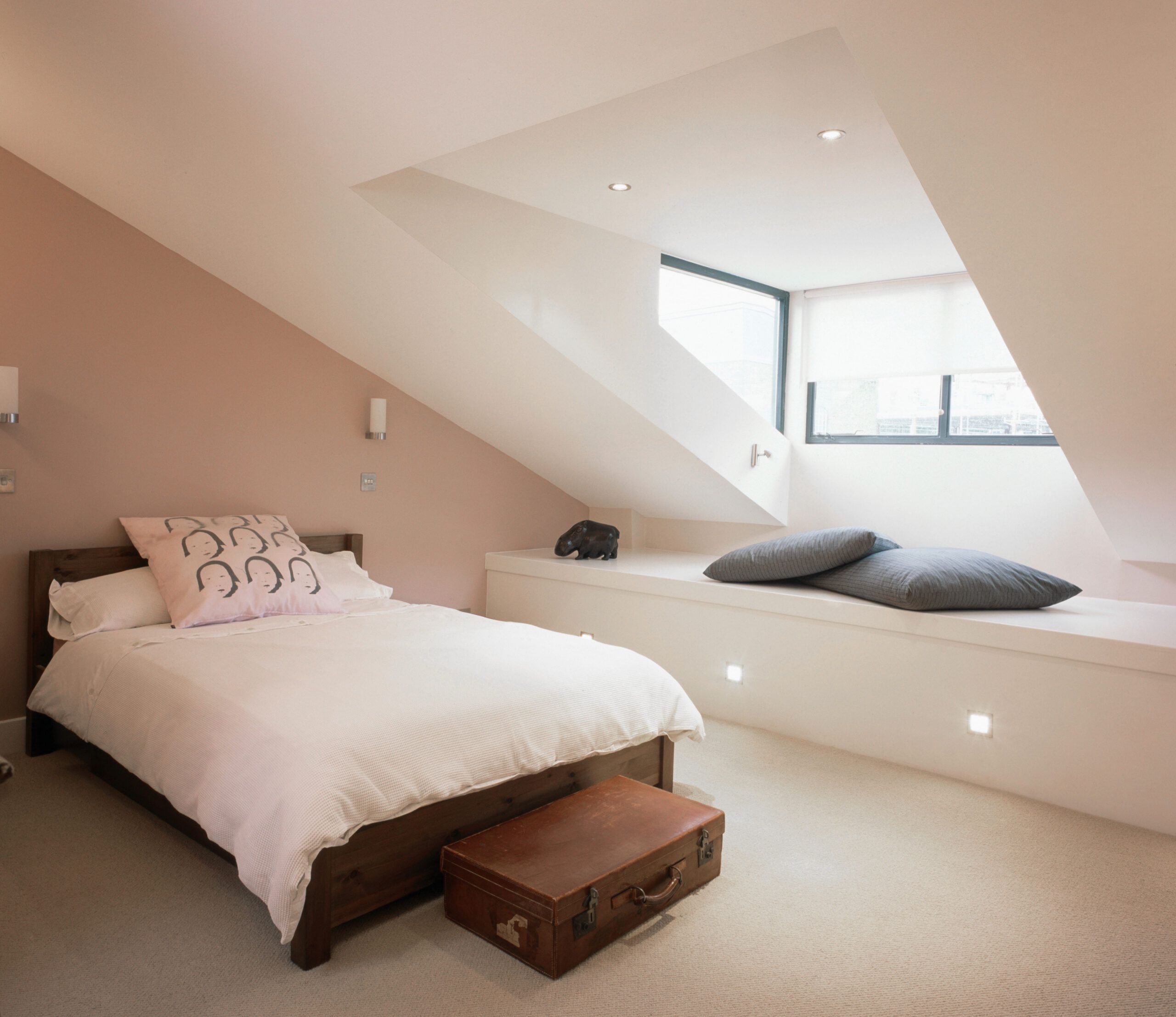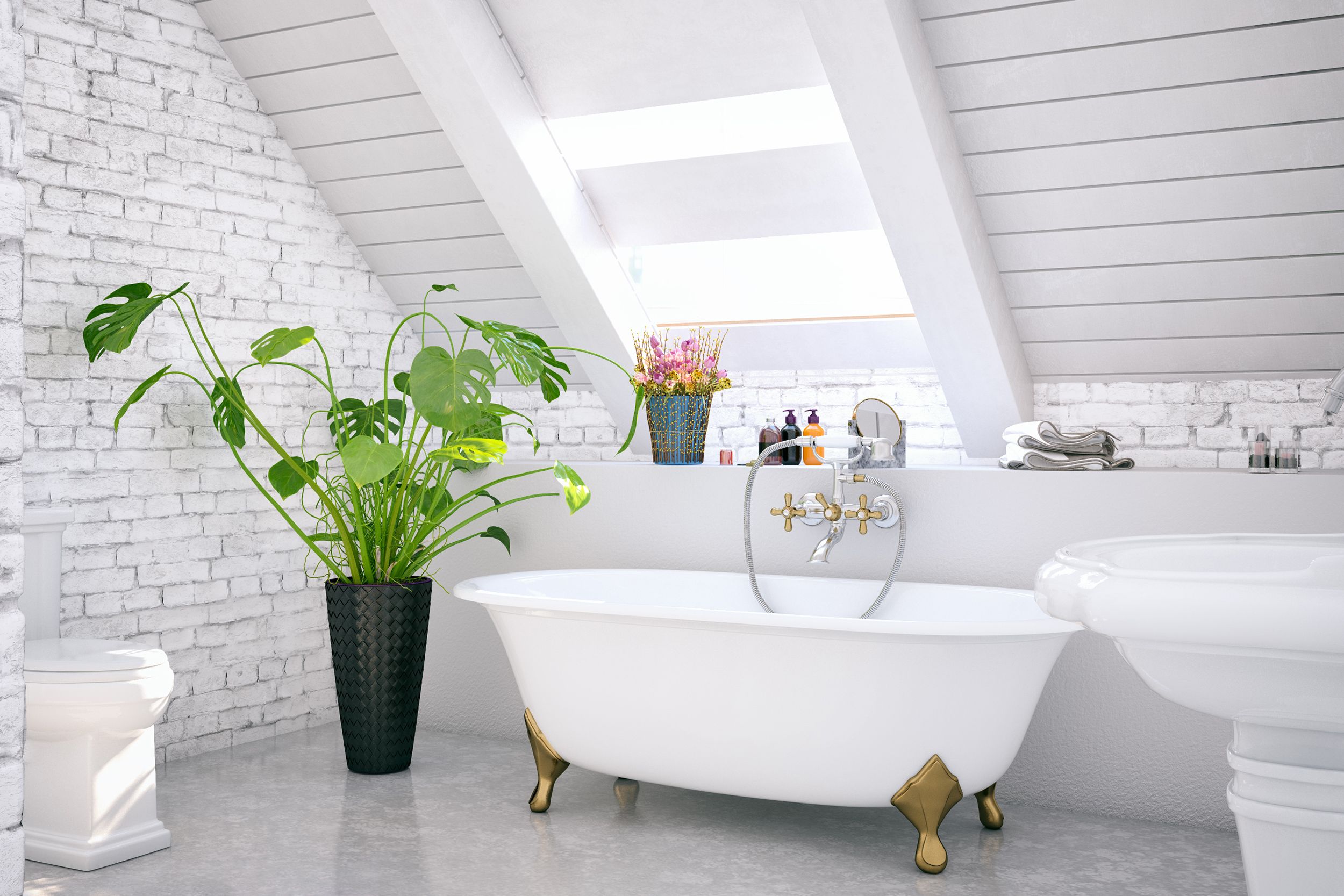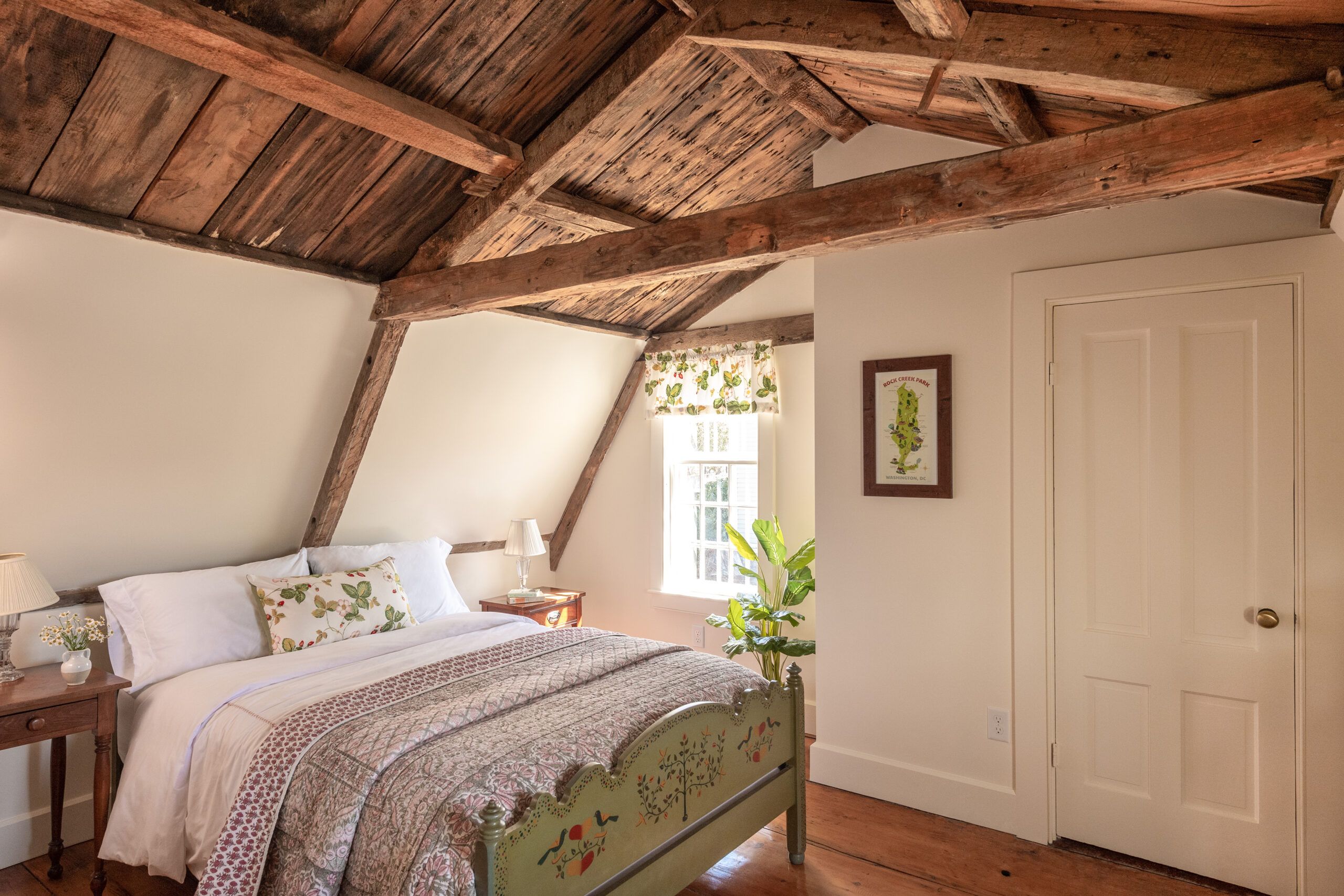Transform your unused attic into valuable living space. Our guide will help you plan a successful attic renovation from start to finish.
Transforming your attic from a dusty storage space into a comfortable living area offers several benefits both now and when you’re ready to sell your home. A finished attic increases the square footage of your home and makes it more attractive to buyers, which can translate to a quicker sale and higher price. In the meantime, you can use the extra space for any number of things—from a home office to a kid-friendly game room.
Our guide covers the essentials of finishing your attic, from researching building codes to choosing the right flooring and lighting. Explore how much an attic renovation costs, whether it’s worth the money, and how to plan your project.
Is an Attic Renovation Worth It?
According to a 2022 report by the National Association of Realtors (NAR), a full attic conversion is one of the most rewarding home improvement projects you can undertake. Homeowners reported high levels of satisfaction after converting their attic to usable living space, with 100% having a greater desire to be home and 73% having a greater sense of enjoyment when home.
Whether an attic renovation is worth it for you depends largely on your budget and plans for the space, as well as the work and costs involved. For homeowners who plan to stay in their homes long-term, the improved functionality is often worth the cost. Those looking to sell soon might want to prioritize projects with a higher return on investment (ROI), though a finished attic can still be a valuable selling point. Even a simple attic renovation that adds insulation and lighting can make the space more appealing to potential buyers.
However, the cost of attic renovations can vary greatly depending on the scope of the project, with simpler finishes being considerably more affordable. The ROI also varies depending on the specifics of your project and whether it increases your home’s official square footage.
Building Codes and Zoning Requirements for Finishing Your Attic
If you’re planning to sell your home in the future, remember that your finished attic must meet very specific requirements to count as a habitable space. Otherwise, the new space won’t count toward your home’s total square footage. Failure to comply with building codes can also lead to costly delays, fines, or the need to redo work.
Building codes vary by location, but here are a few common considerations:
- Access: The attic should have a permanent staircase with handrails and the proper dimensions for safe and easy access.
- Ceiling height: At least half of the floor area should have 7-foot ceilings. A roof pitch of 7/12 or higher is ideal—otherwise, you may need to raise the roof or add dormer windows to create enough headroom.
- Fire safety: A finished attic should have smoke detectors, fire-resistant materials, and an egress window in any bedroom for emergencies.
- Floor area: A finished attic should have at least 70 square feet of usable floor space.
- Structural integrity: A structural engineer should ensure that the attic can handle the added weight of the drywall, flooring, furniture, walls, and fixtures.
We recommend consulting with local building authorities early in the planning process to make sure you understand the specific building codes and zoning requirements in your area. If you’re planning any plumbing or electrical work, hire a licensed professional to ensure code compliance. An experienced contractor can help you obtain the necessary permits, schedule inspections, and navigate any other local requirements.
Attic Insulation and Ventilation Considerations
If you want to use your attic for more than storing airtight plastic boxes, you’ll need to implement a few climate control measures to transform it into a comfortable living space.
Proper Insulation
Insulation acts as a barrier that keeps conditioned air in and unconditioned air out. It helps keep your attic cool during the summer and warm during the winter, improving energy efficiency and reducing the strain on your HVAC system. It also helps prevent moisture buildup and ice dams.
For most climate zones, the U.S. Department of Energy recommends using insulation with a total R-value of R49 to R60 in your finished attic. If you live in a warmer climate or have 3–4 inches of existing insulation in your attic, you may only need to add attic insulation in the R38–R49 range.
Common choices for attic insulation include fiberglass batts and loose-fill fiberglass, which you can supplement with spray foam or rigid foam boards. To learn more about how to insulate an attic with fiberglass, check out the video below with general contractor Tom Silva:
Adequate Ventilation
Attic ventilation helps with energy efficiency and to prevent moisture issues, such as mold and mildew growth. A balanced ventilation system should include both intake and exhaust vents to create a continuous flow of air. Typically, air comes into your attic through soffit vents and exits via gable or ridge vents. In addition to these passive vents, you may want to install an attic fan to actively ventilate the area—especially during warm weather.
Heating and Cooling
You have two basic options for heating and cooling your finished attic. First, you can add ductwork or vents to extend your existing HVAC system into the attic. For many homes, a more efficient alternative is to install a ductless mini-split system to heat and cool your attic independently from the rest of the house.
Consider installing a ceiling fan, too. You can change the direction of the blades based on the season. Counterclockwise movement will produce a refreshing breeze in the summer, while clockwise movement at a low speed creates an updraft that redistributes warm air.
Attic Flooring Options
Before installing flooring, you’ll need to create a sturdy subfloor. Most finished attics have plywood subflooring, which is both strong and affordable. If you go this route, we recommend investing in 3/4-inch tongue-and-groove plywood. Be sure to properly secure the decking to the floor joists with screws. Other options include water-resistant oriented strand board (OSB) or AdvanTech subflooring.

On top of the subfloor, you can install the finished flooring of your choice. Popular options include carpet, laminate, engineered hardwood, or vinyl planks. Flooring costs can vary wildly based on the quality of the product and whether you choose a do-it-yourself or professional installation.
We recommend lightweight materials with a low profile. Heavy ceramic or stone tile will put extra strain on your attic joists, while thick carpet, padding, or hardwood planks will reduce the available headroom.
Attic Lighting Ideas
You can install traditional light fixtures in your finished attic, but we recommend lower-profile options. Installing a skylight will bring in natural light and create an airy feel while freeing up a little extra headroom in the attic ceiling. Recessed or track lighting are unobtrusive options that you can often adjust to highlight specific areas. For lamp-like lighting without sacrificing floor space, consider wall sconces.

Be sure to hire a licensed electrician to install new outlets and lighting circuits. They’l ensure that all electrical work is done safely and up to code.
Attic Renovation Costs
Renovating your attic can cost anywhere from $30 to $200* per square foot, depending on what you have and what you want. For instance, a simple storage area will be far less expensive than a finished bedroom or bathroom with plumbing and high-end finishes. The layout and condition of your existing attic will also affect the cost. Poor insulation, a low ceiling, and awkward angles will increase the work and materials needed to create a functional and livable space.
On the lower end of the spectrum is a bare-bones finish that includes drywall, budget flooring, and a light. This type of renovation would leave you with a more comfortable storage space, but it wouldn’t give you a truly livable space. Converting your attic into a fully furnished bedroom suite will cost significantly more—up to $80,000 for an average-sized attic.
Here’s a breakdown of some of the basic finishing tasks and their estimated costs:
- Adding a bathroom: $8,000–$35,000
- Building a staircase: $950–$3,200
- Electrical work: $500–$3,000
- Finished ceiling: $200–$12,000
- Floor joists and subfloor: $1,500–$10,800
- Heating and cooling: $1,000–$5,000
- Installing windows: $2,500–$5,500
- Insulation and drywall: $2,000–$6,300
You can save money by doing some tasks yourself, such as installing a fan and insulation. Don’t forget to factor in the cost of furniture, paint, and decor.
*Unless otherwise noted, cost data in this article was sourced from contractor estimates used by Angi.

Increasing Home Value With an Attic Remodel
The cost of a full attic conversion is high but NAR estimates a respectable 75% ROI. This figure is based on the $100,000 cost estimate provided by the National Association of the Remodeling Industry (NARI) and the associated $75,000 increase to home value projected by NAR.
A finished attic can boost your home’s value by increasing the usable space and listable square footage. You can use your attic remodel to add an entertainment area, home office, or playroom. You may even be able to convert your attic into a spacious primary suite, giving your home a one-bedroom, one-bathroom edge over similarly sized homes.
Planning Your Attic Remodel
Transforming your attic into a functional living area requires careful planning, from defining the purpose of the room to setting a realistic timeline and budget. Follow these steps to plan a successful attic remodel:
- Assess the feasibility. Before anything else, determine if your attic is suitable for renovation. We recommend consulting a structural engineer for a professional assessment.
- Define the purpose of the space. Decide how you want to use the finished attic space. This will help guide your design choices, budget, and material selection.
- Establish a budget. Research average costs in your area and set a realistic budget that accounts for materials, labor, and permits. Be sure to leave some wiggle room for unexpected expenses.
- Hire experienced contractors. Enlist the help of properly licensed professionals for tasks such as electrical work, plumbing, and HVAC upgrades. Experienced contractors can help you navigate local building codes and ensure the project is completed safely and efficiently.
- Create a design plan. Sketch out a basic floor plan and design for your attic space. Consider factors such as layout, lighting, electrical outlets, and storage options.
- Secure necessary permits. Check with your local building department to determine if any permits are required for your attic renovation. Make sure you have all the necessary approvals before starting any work.
- Set a realistic timeline. Establish a timeline that accounts for potential delays and unforeseen challenges. This will help manage expectations and keep your project on track.
Our Conclusion
Finishing your attic can add valuable square footage to your home and transform a neglected space into a useful bonus room. Whether you envision a secluded master suite, a cozy reading nook with a window seat and built-in shelves, or an entertainment area, an attic remodel could boost your home’s value and your enjoyment of it.
Before starting this project, think through your goals and budget for the space. Attics pose unique challenges that could make a full renovation impossible or impractical. Consult with professionals to assess the structural integrity of your attic and ensure compliance with local building codes. An experienced contractor can also help you make informed decisions about insulation, ventilation, flooring, and lighting.
FAQ About Attic Renovation
Whether finishing an attic is worth it depends on your plans and budget. Finishing an attic is usually worth it if you plan to stay in your home for a while. It will also increase your home’s value when it’s time to sell. However, if you plan to sell in the near future, your money may be better spent on projects with a higher ROI.
Renovating an attic typically costs $30–$200 per square foot, with most homeowners paying a total of $10,000–$50,000.
You can’t remodel every attic. Some attics lack sufficient headroom, while others don’t have strong enough joists to support the weight of a finished space. Local building codes often have specific requirements for attic renovations, such as minimum floor space, ventilation, and fire safety measures.
The first steps to renovating an attic are consulting a structural engineer and researching local building codes. You’ll then need to address structural issues, obtain the necessary permits, and ensure proper insulation and ventilation before finishing the space.
The 7 and 7 rule for attic conversions refers to the common requirement that finished attics be at least 7 feet wide and 70 square feet, with 7-foot ceilings over at least half. Keep in mind that this is a general guideline. Local building codes may have stricter requirements that supersede this rule.
To share feedback or ask a question about this article, send a note to our Reviews Team at reviews@thisoldhousereviews.com.

